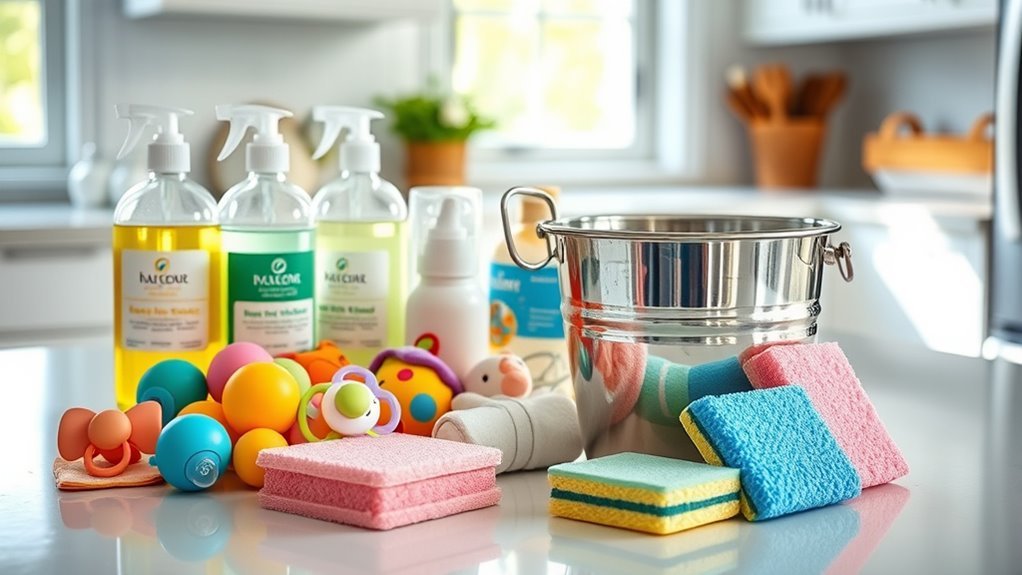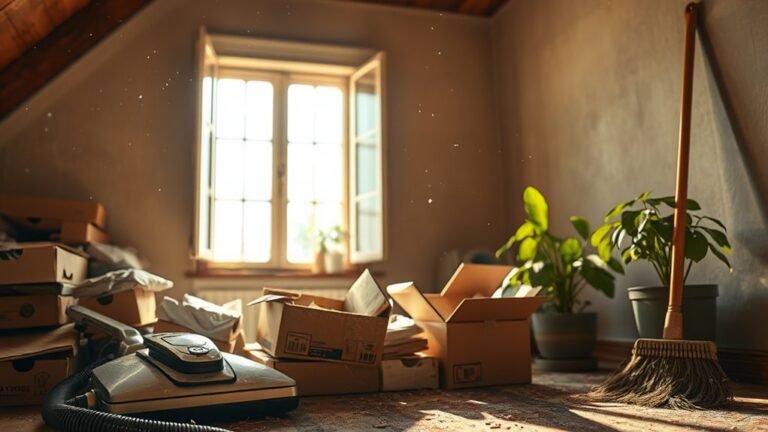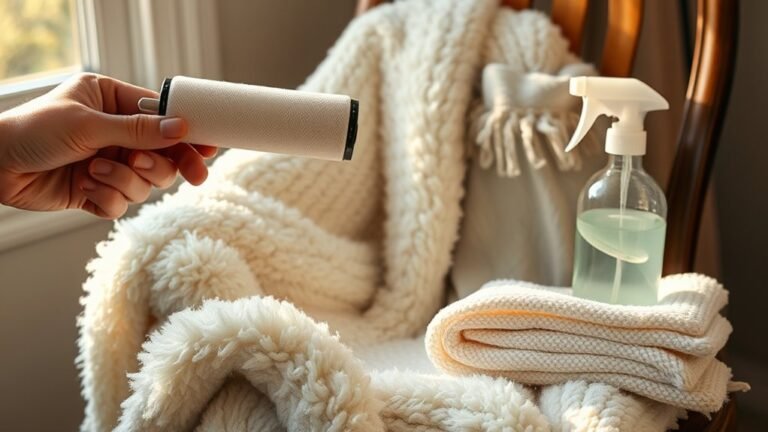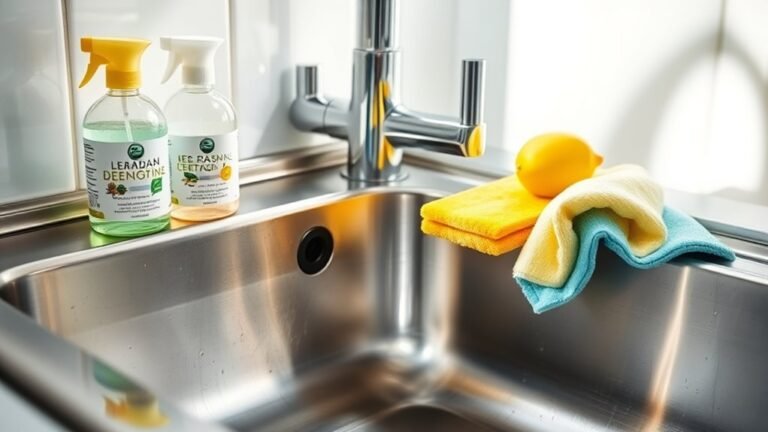Deep Cleaning Checklist for Baby Items
To deep clean your baby’s items, start by disassembling bottles and sterilizing parts with boiling water or steam. Sanitize pacifiers by boiling and clean teething toys with mild soap or natural solutions. Wash soft toys gently, following care labels, and strip crib bedding for hot washing. Disinfect high chairs and play areas regularly, focusing on crevices and straps. Don’t forget to maintain your baby’s clothes with gentle detergents. Keep going to discover more essential tips for a safe, spotless environment.
Cleaning Bottles and Feeding Accessories

When it comes to cleaning bottles and feeding accessories, you’ll want to be thorough to keep your baby safe from harmful bacteria. Start by disassembling all parts and rinsing them with warm water to remove milk residue. Depending on the feeding accessory materials—whether silicone, plastic, or glass—you’ll choose the right bottle sterilization techniques. For plastic, avoid harsh chemicals or high heat that could degrade the material. Boiling, steam sterilizers, or microwave sterilizer bags are effective for most materials, offering freedom from harmful germs without harsh chemicals. Regularly inspect nipples and rings for wear. Prioritize thorough cleaning after every use, combining soap, water, and proper sterilization to guarantee your baby’s feeding gear stays pristine and safe, giving you peace of mind and freedom from worry.
Sanitizing Pacifiers and Teething Toys
Sanitizing pacifiers and teething toys is essential to keep your baby safe from germs that can cause illness. You want to guarantee these items stay clean without compromising your freedom to explore better, easier methods. Different teething toy materials require specific care, so understanding them is key. Here’s how you can keep pacifiers and teething toys sanitized:
Keeping pacifiers and teething toys clean protects your baby and allows you to find easier, safer cleaning methods.
- Boil pacifiers for 5 minutes, then store them in a clean pacifier storage container to avoid contamination.
- For teething toys made from silicone or rubber, wash with warm, soapy water, then rinse thoroughly.
- Avoid harsh chemicals; instead, use natural sanitizers like vinegar solutions for wooden teething toys to maintain their integrity.
Washing Soft Toys and Fabric Items

Since soft toys and fabric items easily trap dust, dirt, and germs, you’ll want to wash them regularly to keep your baby’s environment healthy. Start by checking the care labels to follow proper fabric care instructions, ensuring you don’t damage delicate materials. Use a gentle detergent free from harsh chemicals to protect your baby’s sensitive skin and maintain toy safety. For machine-washable items, place them in a mesh laundry bag to prevent wear and tear. If the toy isn’t machine-safe, spot clean with a mild soap and warm water, then air dry completely. Regular washing not only preserves the softness and appearance but also reduces allergens, giving your baby a cleaner, safer space to explore freely.
Deep Cleaning Crib and Bedding
Although your baby’s crib and bedding may seem clean at a glance, they can harbor dust mites, allergens, and germs that affect your little one’s health. To maintain crib safety and comfort, deep cleaning is essential. Here’s how you can do it effectively:
- Strip all bedding materials, including sheets, mattress covers, and blankets, and wash them in hot water to eliminate bacteria and allergens.
- Vacuum the crib mattress and frame thoroughly, reaching corners and crevices where dust accumulates.
- Wipe down the crib’s surfaces with a gentle, baby-safe cleaner to remove residue and potential irritants.
Disinfecting High Chairs and Play Areas

High chairs and play areas are hotspots for germs because your baby spends so much time eating and playing there. To keep high chair hygiene in check, wipe down all surfaces after each meal with a baby-safe disinfectant. Don’t forget the tray, straps, and any crevices where crumbs hide. For play area safety, regularly clean toys and mats with mild soap and water, then disinfect to kill lingering bacteria. Make it a habit to vacuum or mop floors to reduce dust and germs too. Staying consistent with these steps gives you peace of mind, knowing your baby’s environment is clean and safe. You’re not just cleaning—you’re creating a healthy space where your little one can explore freely without unnecessary risks.
Maintaining Baby Clothes and Laundry Hygiene
When you care for your baby’s clothes, proper laundry hygiene is essential to keep their skin safe and healthy. Handling baby laundry with attention to fabric care prevents irritation and keeps clothes fresh. Here’s how you can maintain that freedom from worries:
- Use gentle, fragrance-free detergents designed for sensitive skin to avoid allergic reactions.
- Wash baby clothes separately from adult laundry to minimize exposure to harsh chemicals and bacteria.
- Opt for cold or warm water cycles, as hot water can damage delicate fabrics and cause shrinking.
Frequently Asked Questions
How Often Should I Deep Clean Baby Items for Newborns?
You should keep baby hygiene in mind by deep cleaning newborn items regularly, but don’t stress overdoing it. Aim for a cleaning frequency of about once a week for most items, unless something gets visibly dirty or your baby’s been sick. This balance lets you maintain a healthy environment without feeling tied down. Remember, staying consistent with cleaning helps keep your little one safe while giving you freedom to enjoy parenting.
What Natural Cleaning Products Are Safe for Baby Items?
You’ll want to choose baby safe cleaners that are gentle yet effective. Look for eco friendly options like white vinegar, baking soda, and mild castile soap—they’re natural, non-toxic, and won’t irritate your little one’s skin. These ingredients let you clean confidently without harsh chemicals, giving you the freedom to keep baby items spotless and safe. Just remember to rinse thoroughly, and you’re good to go!
Can I Use a Dishwasher to Clean Baby Bottles?
Imagine Sarah, who’s always on the go, using her dishwasher to clean baby bottles. You can, too—dishwasher safety for bottles depends on the model and materials. Many bottles say they’re dishwasher-safe on the top rack. Just remember, bottle sterilization methods like boiling or steam sterilizers provide extra germ-killing power. Using your dishwasher is a convenient option, but combining it with occasional sterilization guarantees your baby’s bottles stay truly clean and safe.
How Do I Prevent Mold Growth on Baby Toys?
To prevent mold growth on baby toys, you’ll want to focus on mold prevention by keeping toys dry and clean. After washing, make sure toys are completely air-dried before storing them. Use breathable toy storage like mesh bags or open bins to avoid moisture buildup. Regularly check for any dampness and clean toys often. This way, you can keep your baby’s playthings fresh and safe without feeling tied down by constant cleaning.
Is UV Sterilization Effective for Baby Item Cleaning?
You might wonder about UV sterilization’s effectiveness assessment for baby item cleaning. It’s a great method because UV light can kill bacteria and viruses without chemicals, giving you freedom from harsh cleaners. However, it’s not foolproof—it only works on exposed surfaces and needs proper exposure time. So, while UV sterilization is effective, it’s best used alongside regular cleaning to keep baby items truly safe and germ-free.






